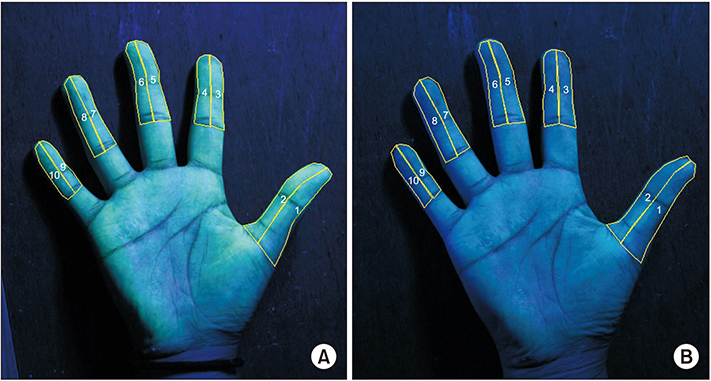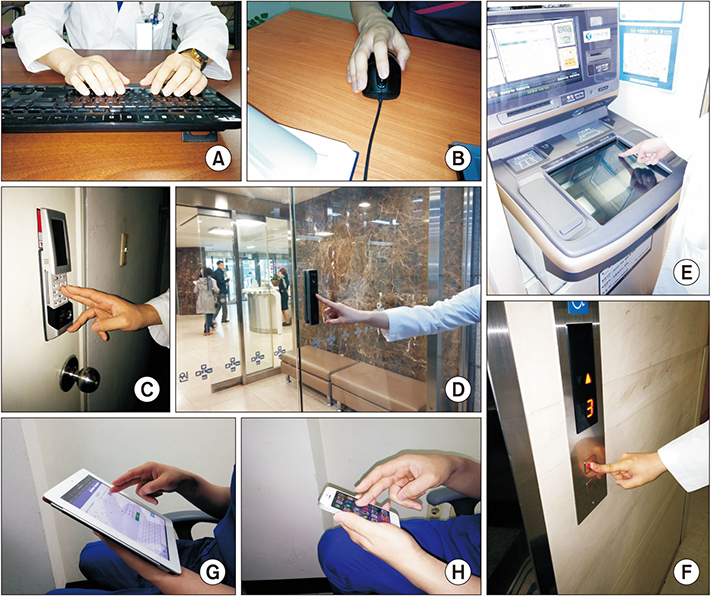Arch Hand Microsurg.
2019 Sep;24(3):203-209. 10.12790/ahm.2019.24.3.203.
Experiment of Radial and Ulnar Sides Sensory Dominance of the Digits in Office Workers by Fluorescent Material Painting
- Affiliations
-
- 1Department of Plastic Surgery, Kosin University College of Medicine, Busan, Korea. immtkg4u@daum.net
- KMID: 2456243
- DOI: http://doi.org/10.12790/ahm.2019.24.3.203
Abstract
- PURPOSE
The radial side of fingers are thought to be the dominant sensory side. With the development of electronic devices and lifestyle changes, we think this should be re-evaluated.
METHODS
We painted fluorescent material on both hands of 26 office workers. Each finger was divided into the ulnar and radial compartment. We analysed how much fluorescent material remained by comparing two pictures, before and after work.
RESULTS
On the dominant hand, significantly more fluorescent material remained on the radial side of the ring and little finger compared with the other compartment. On the non-dominant hand, there was no statistical difference between compartments.
CONCLUSION
In this study, the radial sides of the ring and little finger on the dominant hand seem to be less useful in modern life and these compartments can be sensibly less important. This observation can be used as a basic data for reevaluation of the sensory dominant sides of fingers and it may be helpful in various hand surgery.
Keyword
Figure
Reference
-
1. Khouri RK, Badia A. Reconstructive surgery of individual digits (excluding thumb). In : Mathes SJ, Hentz VR, editors. Plastic surgery. Volume VII. 2nd ed. Philadelphia: Saunders;2006. p. 207–252.2. Tubiana R, Duparc J. Restoration of sensibility in the hand by neurovascular skin island transfer. J Bone Joint Surg Br. 1961; 43:474–480.
Article3. Hashem MA. The heterodigital neurovascular island flap: a sensible solution for difficult digital defects. Kasr El Aini J Surg. 2006; 7:55–62.4. Puckett CL, Howard B, Concannon MJ. Primary closure of the donor site for the Littler neurovascular island flap transfer. Plast Reconstr Surg. 1996; 97:1062–1064.
Article5. Silva JB, Pires FK, Teixeira LF. The pulp switch flap: an option for the treatment of loss of the dominant half of the digital pulp. J Hand Surg Eur Vol. 2013; 38:948–951.
Article6. Ranney DA, Lennox WM. The protective value of a neurovascular island pedicle transfer in hands partially anesthetic due to ulnar denervation in leprosy. J Bone Joint Surg Am. 1978; 60:328–334.
Article7. Hayashi H, Shimizu H. Essential motion of metacarpophalangeal joints during activities of daily living. J Hand Ther. 2013; 26:69–73. quiz 74.
Article
- Full Text Links
- Actions
-
Cited
- CITED
-
- Close
- Share
- Similar articles
-
- Unusual bilateral sensory innervation of the dorsum of hand by lateral antebrachial cutaneous nerve: a case report
- The Distribution Patterns of the Cutaneous Nerves on Dorsum of the Hands in the Korean
- Median and Ulnar Sensory Nerve Conduction Study in Five Digits
- Evaluation of the Forearm Dominancy Artery for Invasive Vascular Procedure with 3D-CT Angiography
- Sensitivity of Multi-electrodiagnostic Parameters in Carpal Tunnel Syndrome: Usefulness of residual latency




